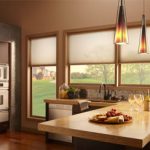How Smart Homes will Change the Way We Live
The way that we live today is a drastic change from the way that we lived 25 years ago. From wireless sound systems and smart phone integrated connections to automated lighting and thermostats with the ability to learn your temperature preferences, modern smart homes are capable of far more than our grandparents may have ever dreamed possible. However, as intelligent as our homes have become, as our world continues to journey forward into new technological advancements, our homes will only become more and more innovative from the inside out.
To learn more, checkout the infographic below created by Custom Audio Video.
The Top Three Consumer Priorities for Current Smart Home Products
Each year, the top reason that consumers convert their traditional abodes into smart homes is for security purposes. Home surveillance cameras that allow access to happenings from anywhere on the globe, smart doorbells that give you the heads up as to who’s on the porch and remote-locking doors for those times when you forget to lock up provide homeowners with the peace-of-mind that they need to feel safe whether they are at home or on the go. Meanwhile, simplicity of use and engaging features like personal communication between man and machine are major driving factors when a consumer is ready to make a purchase. In fact, remote-locking doors are currently the second largest selling smart home product on the market today.
At the time of this article, 72% of all smart home purchases are being made on self-adjusting thermostats that learn more about your unique comfort levels over a period of time. These systems also have the ability to keep certain rooms cooler or warmer while also changing temperatures to suit your needs throughout the day. In addition, 68% of the most in-demand buys go toward master remote systems, which allow a user to control multiple devices from one source, and 65% to both adjustable lighting and home surveillance equipment.
A Growing Demand
Over the next five years or so, experts predict that the demand for smart home industry technology will have tripled. 2014 saw a whopping $49 billion in global revenue pertaining to smart home products; however, by 2019, that number is expected to rise to a staggering $115 billion worldwide. At the present, 28% of Americans own at least one smart home product, while 21% own or rent homes that have working smart home components. 12% of homes in North America are projected to be homes that run completely on smart systems.
The Benefits of a Smart Home
A smart home provides a family with the ability to take their thoughts off of everyday worries and focus them on important business, social and personal issues. From providing greater comfort in the home to generating better security for your family, smart homes have universal appeal, but they also generate specific benefits that serve niche markets as well. For example, smart home innovations can help a family to care for elderly loved ones more efficiently. Through home surveillance and early-alert health technology, family members can feel more comfortable leaving their elderly loved ones home alone when they know that help is just a button away and that they will be able to see what is going on inside of the home to prevent accidents or deal with health emergencies. In fact, 74% of families say that they would sleep better knowing that their parents or grandparents were utilizing smart home technologies of this sort.
Aside from the promise of these niche market items, families find that the everyday perks of smart homes include many benefits that are more universal in nature. 48% of smart home users found that the added convenience offered by smart homes was worth noting to those who were thinking of purchasing like-minded items. 70% of consumers revealed that greater energy efficiencies generated cost-savings in their households due energy-conscious smart home monitoring. 85% of families feel that fire detection is one of the most important benefits of smart home components, which can save lives and prevent or minimize property destruction.
Looking into the Future
The future of smart home technology ignites the imagination of creators, scientists and businesses worldwide. From the way we watch television to the way that we protect our homes and families, many predictions are being made about what is just around the bend in smart home advancements. Whether you are interested in a new experience in home entertainment or increased confidence in your home security and protection system, there is something for every homeowner and lifestyle in the ever-increasing selection of smart home products.
Home entertainment is expected to become more entertaining than ever before with broadcast sporting events becoming interactive, allowing you to communicate with the event as if you were there in person. You could select your favorite leader-board, check out other scores from games around the world and indulge in track position charts that would allow you to be involved in more than one sport at once.
Appliances may seem like a less exciting place to use smart home technology, but this area is actually one of the most innovative of all. Whirlpool’s Connected Kitchen will be able to recognize individual users through biometrics, providing each family member with a unique, personalized cooking experience. Smart Vessels will know when your food has spoiled and will recognize the absence of family staples that may need purchasing. Stoves will be able to recognize pans and pots to cook food to perfection, and recipes will be viewable on your stovetop for easy reading and scrolling for ingredients.
Home security will become something that you might expect to see in a spy film. Someday, your home will be able to allow you entrance through facial recognition—no key necessary. Security systems will recognize specific voices, trigger alarms at the sound of breaking glass and alert parents to the sounds of a crying baby—even if they’re away from the home or nursery.
As we journey into the future of smart home innovation, it is evident that we have a lot to look forward to in the future. Today’s smartest residence will be nothing when compared to the I.Q. level of tomorrow’s home.
Add This Infographic to Your Site










